The photograph known as ‘Mykene 63’, which allegedly shows Heinrich Schliemann standing next to the famous Lion Gate of Mycenae, is undoubtedly one of the most renowned images kept in the photographic archive of the DAI Athens. Since this year marks Heinrich Schliemann’s 200th birthday, it is a fitting occasion to set the record straight and tell the real story behind this picture. We will also pursue some of the other threads connected to its story.
The belief that D-DAI-ATH-Mykene-0063 – the photograph’s official name – shows Schliemann in the upper right, standing next to the lion (figs. 1, 2), seems to be common knowledge (Döhl 1981, cover; Rottloff 2009, cover and frontispiece). Even the Wikipedia entry on Schliemann repeats this claim, dating the picture (without evidence) to 1885.
Without going into detail about the history of our photographic archive, suffice it to say that the archive does not have
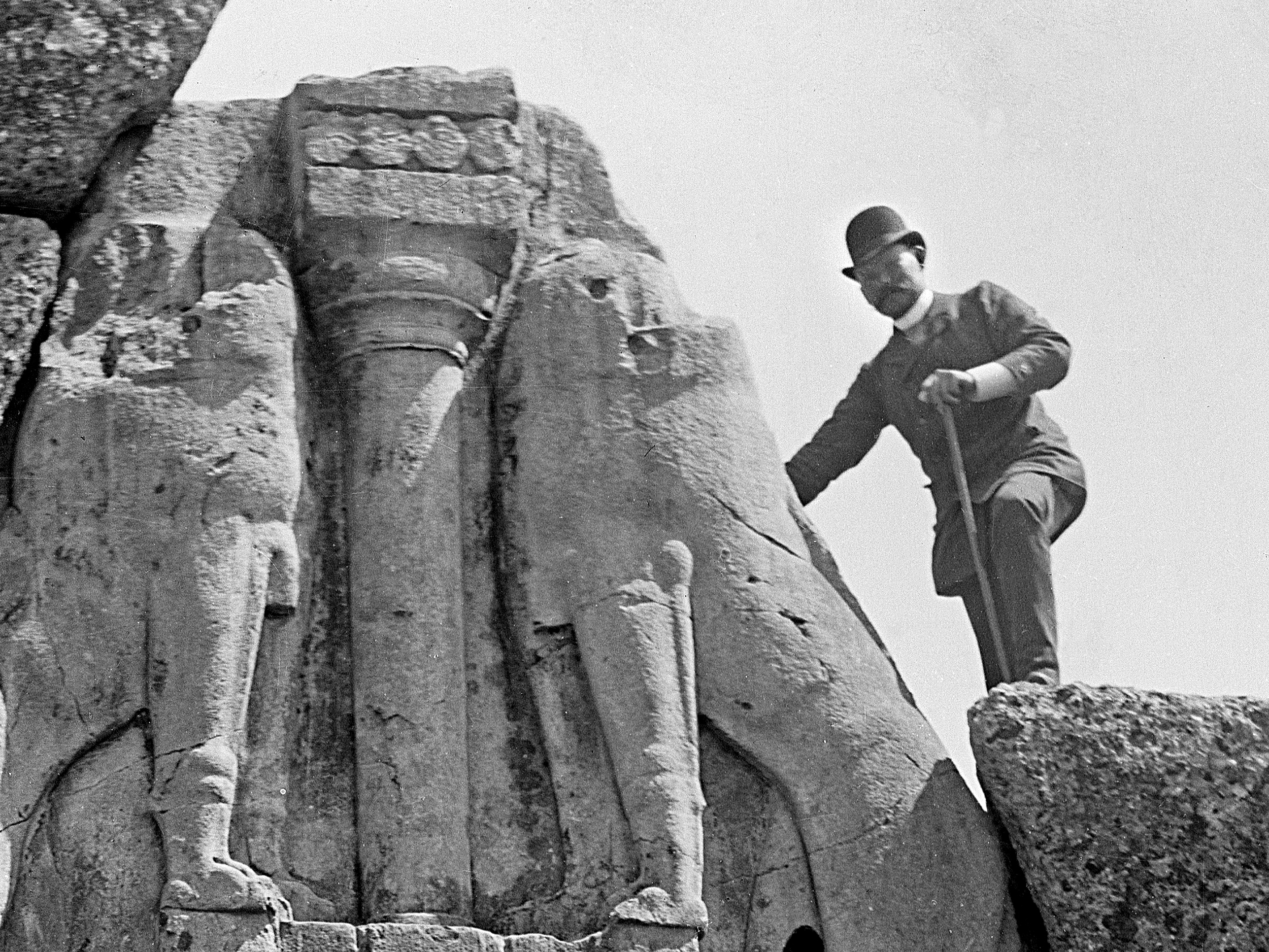
any pictures from 1885 and only very few from 1886. ‘Mykene 63’ was inventoried and numbered as a single entry in 1898. Consequently, we know for certain that the image cannot have been taken later than 1898; it might have been taken earlier, but nothing points specifically to the year 1885.
Let’s look at the ‘Schliemann assumption’ from a different point of view: Schliemann was born in 1822 and would have been 63 years old in 1885. Although he was a very energetic personality, images of Schliemann at this age (American School of Classical Studies at Athens) clearly show that he was no longer a young man with a robust physique like that of the man in the photograph (fig. 1). It also is highly unlikely that Schliemann would have been eager, at his age, to undertake the rather youthful endeavour of climbing the gate. Moreover, by 1885, he had been familiar with Mycenae for more than a decade, since his own excavation of the site in 1874–1876. None of these considerations, of course, amounts to decisive proof that the person in the photograph is not Schliemann.
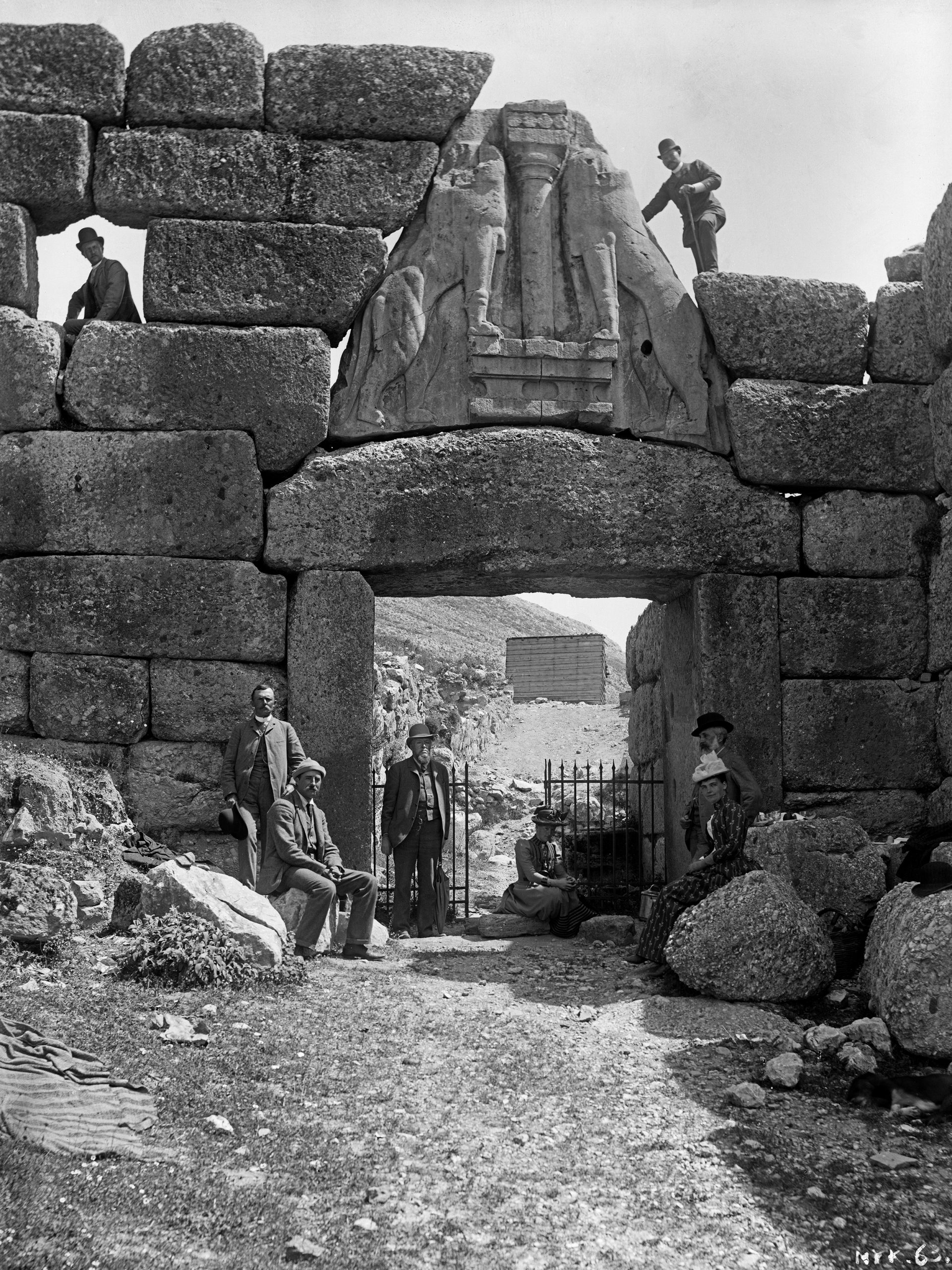
What else do we know about the image that might help clarify its date and the identity of the person identified as Schliemann?
At least two people shown in the photograph can easily be recognized: Wilhelm Dörpfeld, who is standing to the left of the gateway, and his wife Anne Dörpfeld, who is sitting on the threshold of the gate (fig. 3).
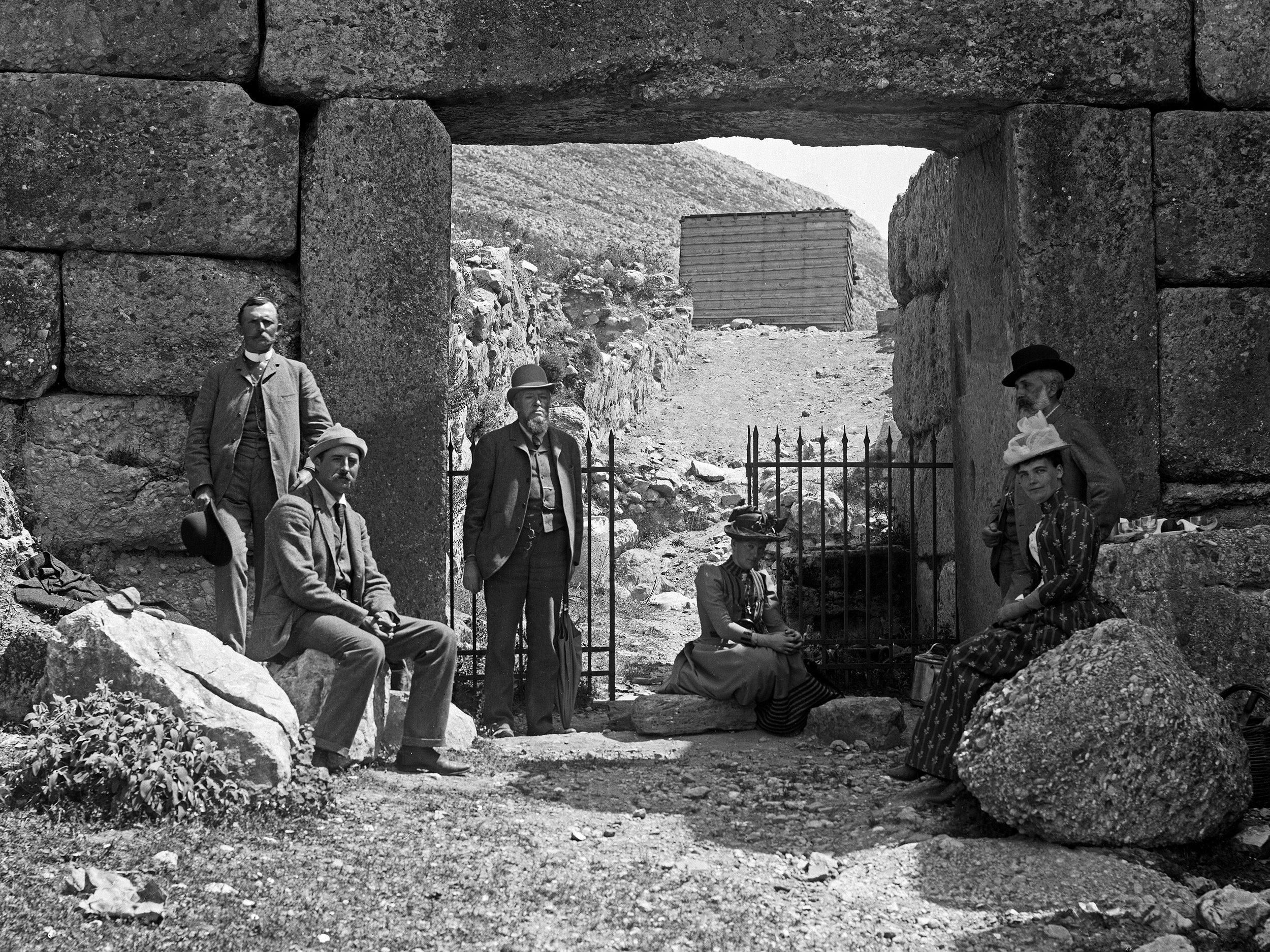
Since both of the Dörpfelds are wearing rings, the photo was taken after 1883, the year of their wedding. This fact, however, does not help us to narrow down the date of the photograph. We may also note, however, two clues: first, Dörpfeld himself is no longer a young man, and second, the photograph was undoubtedly taken in the spring, as indicated by the blooming flowers captured in the photograph, particularly in the lower left corner (fig. 2).
Recently, a few papers came to light in DAI Athens photo archive that enable us to solve the mystery. The papers in question list 203 photographs under the rubric ‘Diverse Privat” (‘various private’), together with a brief description of each and the approximate date when they were taken (figs. 5. 6). The list in fact comprises part of Dörpfeld’s own private collection of photographs, most of which were taken on Institute trips. These photographs therefore were not included in the photo archive of the DAI Athens, but rather were kept by Dörpfeld himself. Since a few photographs that are preserved with the Dörpfeld papers in the Stadtarchiv Wuppertal (Municipal Archive of Wuppertal) are labelled ‘Pri. 000’ we have been able to identify one of them, a photograph of Dörpfeld and a group of travellers at the Heraion of Olympia (fig. 4), with one of the pictures described on the list, namely ‘Pri. 73’.
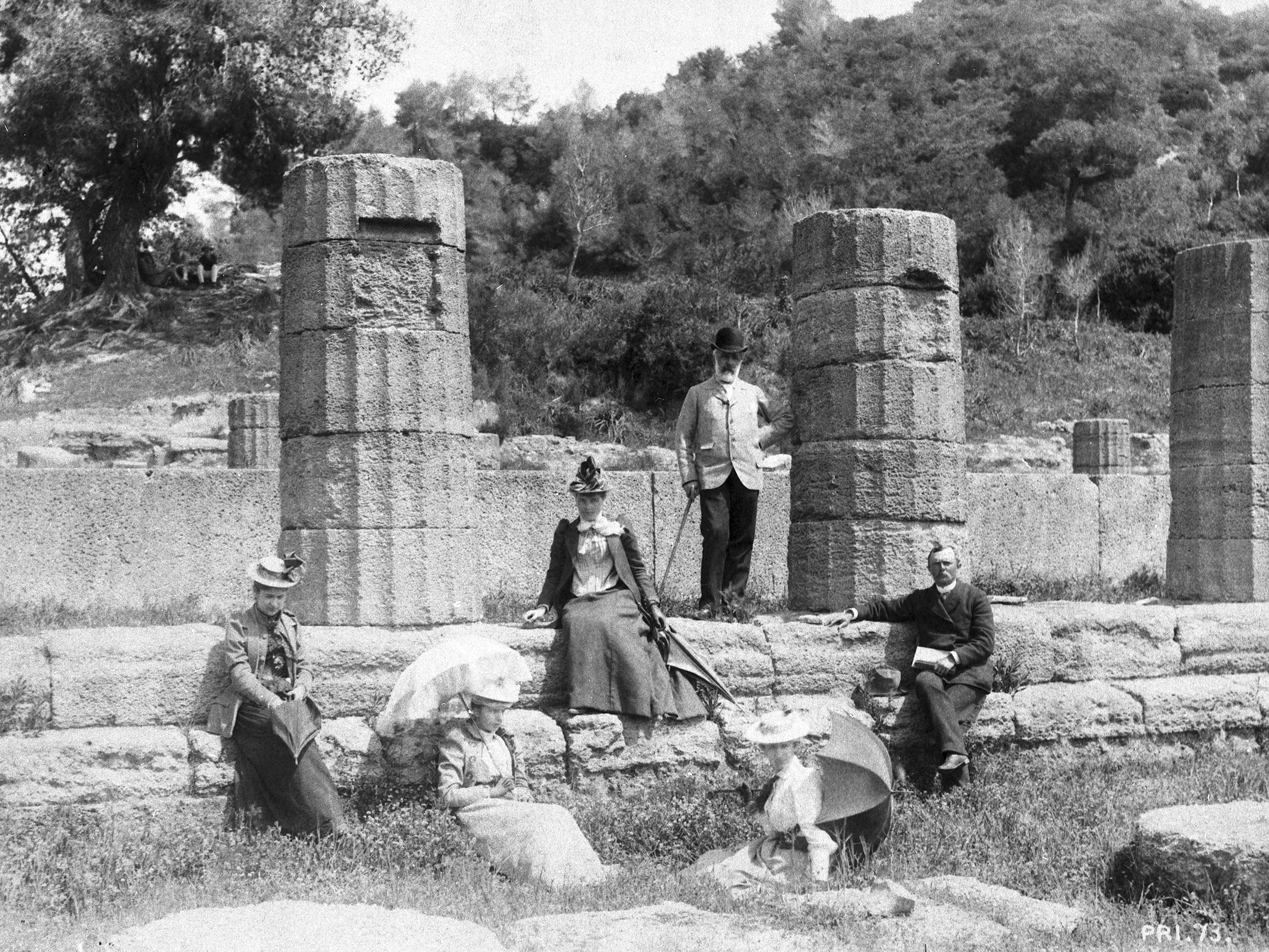
According to the ‘private’ list entry no. 73, this photo was taken in 1892 (fig. 5). The name of one “Graf von Wesdehlen” (Count von Wesdehlen) is given as further description. The only man in the Olympia photograph ‘Pri. 73’ other than Dörpfeld is a distinguished gentleman standing at the centre. He must be Count von Wesdehlen.
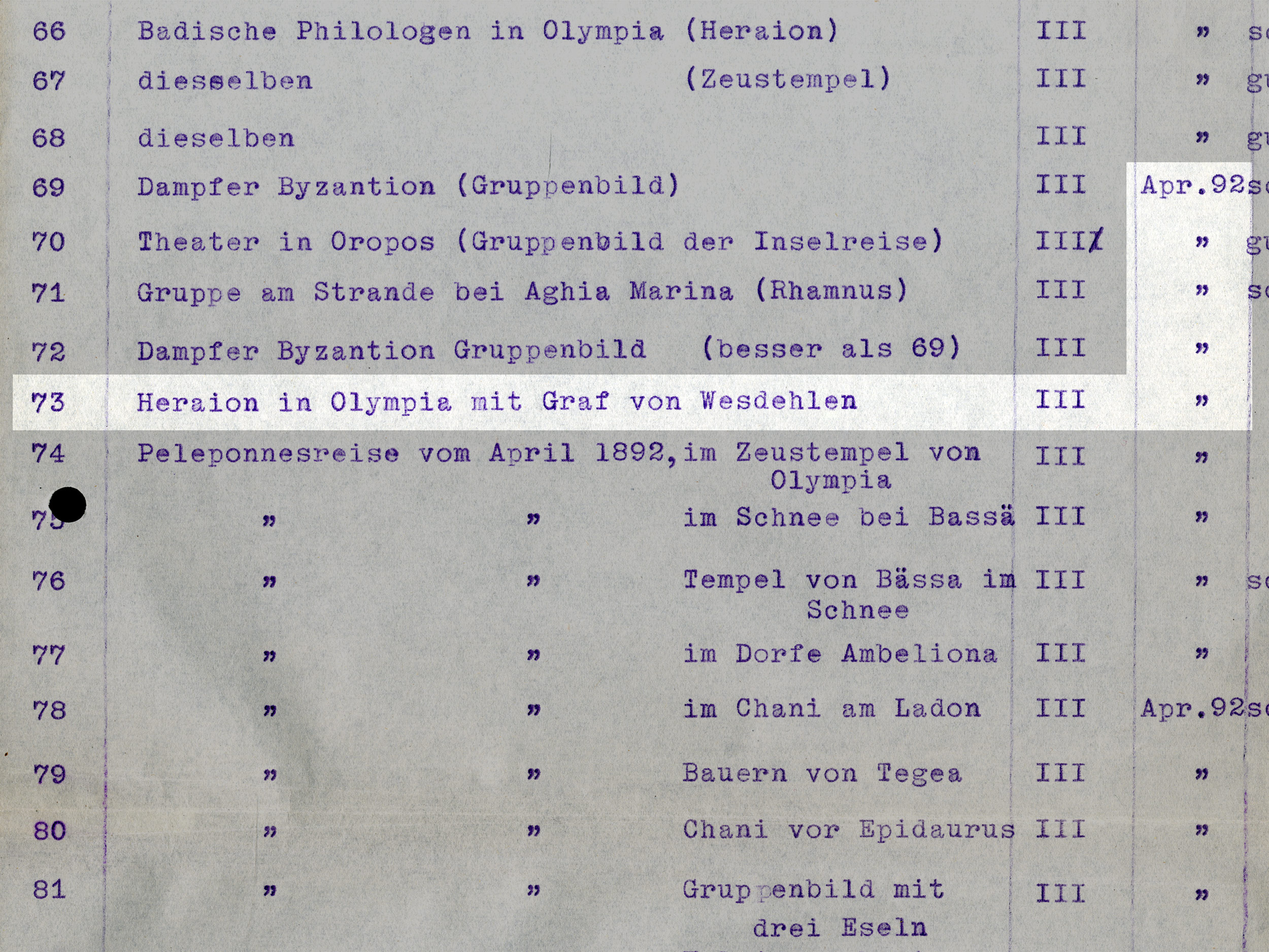
Coincidentally, images 42 and 48 on the ‘Private’ list also mention the count. The descriptions of these pictures read “Löwentor mit Graf Wesdehlen” and “Löwentor in Mykenä mit Graf Wesdehlen”: they thus were both taken at the Lion Gate at Mycenae, both feature Count von Wesdehlen and both date to May 1891 (fig. 6).
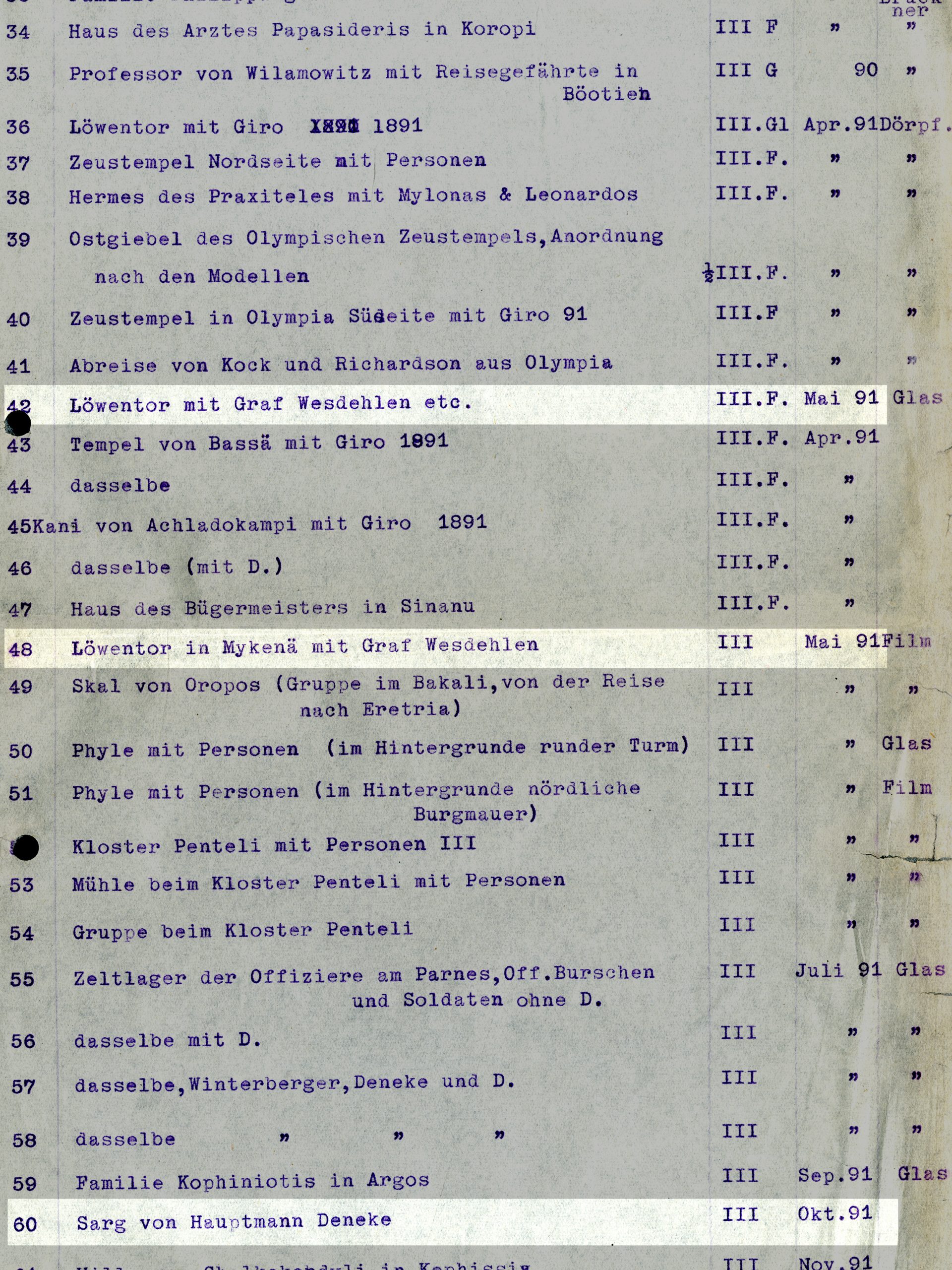
If we compare the man photographed in Olympia to the man standing on the right side of the Lion Gate at Mycenae in ‘Mykene 63’, we recognize that they are the same person, obviously Count von Wesdehlen (fig. 4. 7).
Who was Count von Wesdehlen? A quick Internet search reveals that Ludwig Friedrich Graf von Wesdehlen (1833–1904) (Bringmann 2001, 76–77) was the German ambassador to Greece from 1890 to 1894 (https://de.wikipedia.org/wiki/Liste_der_deutschen_Botschafter_in_Griechenland).
In 1868, Wesdehlen had married Augusta Alexandrine von Pourtales, who was seventeen years younger. Since the same younger woman appears sitting close to Wesdehlen both in the picture taken at the Heraion (fig. 4) and in the picture taken at the Lion Gate (fig. 7), we may conclude that she was indeed his wife.
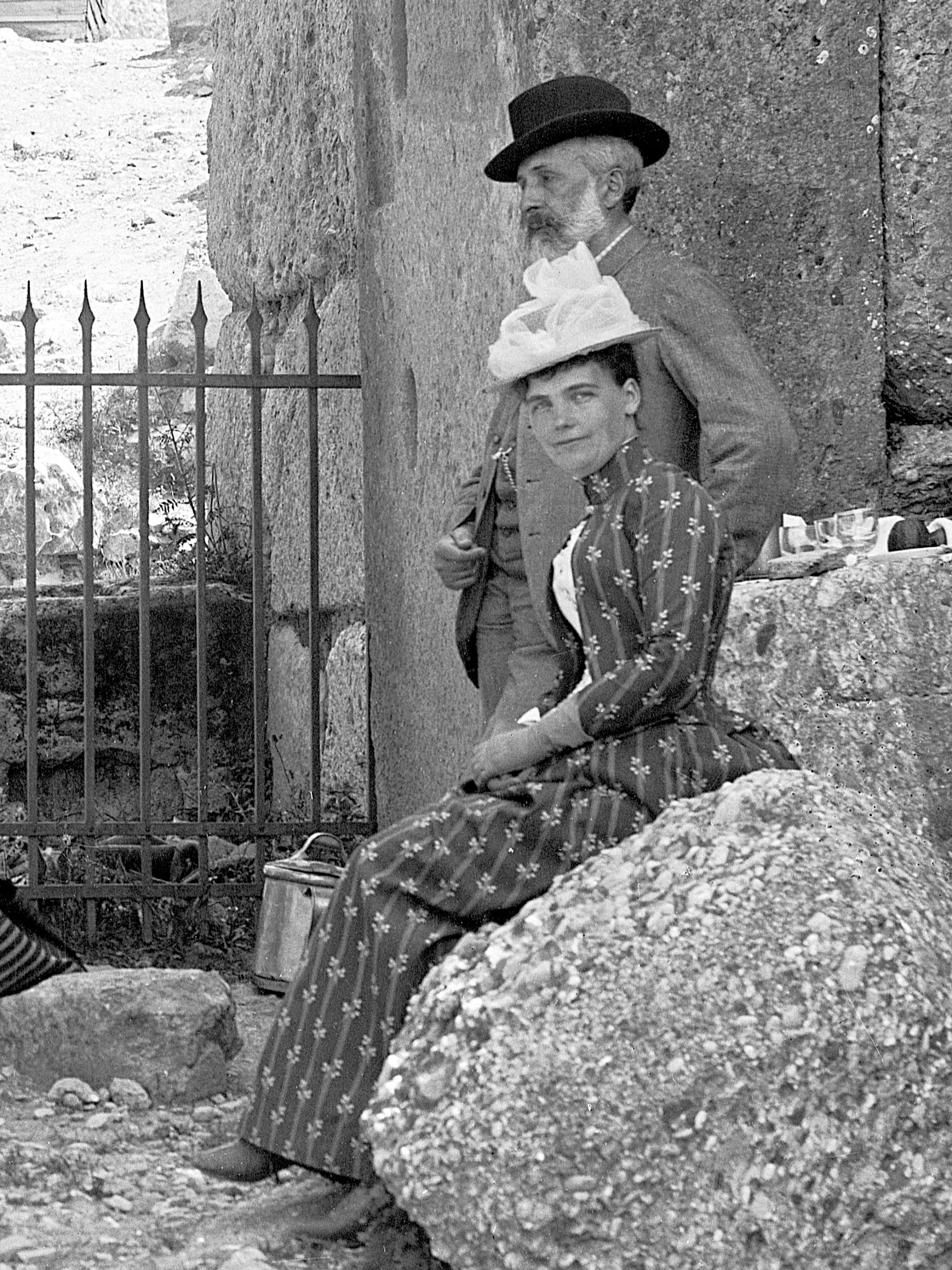
As stated above, Wesdehlen’s tenure at the German Embassy of Greece commenced in 1890, but we do not know the precise date of his arrival. The photograph ‘Mykene 63’ thus could have been taken in the spring of 1890, when Schliemann was still alive and might have joined the group of visitors. However, both the copybook of Schliemann’s letters from 1890 and his excavation diary, which are kept today in the Gennadius Library of the American School of Classical Studies at Athens, inform us that Schliemann sent letters from the Dardanelles as early as February 28th 1890, and undertook excavations at Troy from March 23rd to July 27th of that year. In light of the blooming flowers and the light clothing worn by the people in the photograph, it is obviously highly unlikely that the photograph could have been taken in February, while Schliemann was still in Greece. Schliemann died in December 1890. We thus can rule out the possibility that it is Schliemann who was photographed with Wesdehlen at Mycenae. Although it is impossible to determine in exactly what year the photograph was taken, the evidence above and Dörpfeld’s ‘private’ list of photographs in particular point to the spring of 1891, several months after Schliemann’s death.
Count von Wesdehlen – social pleasantries with ‘Philadelphia’ and the DAI Athens, and the officers of the topographic project ‘Karten von Attika’
Having solved the initial question concerning ‘Mykene 63’, let’s pick up the thread of Count von Wesdehlen and his wife. They are actually mentioned several times in records from these years. Julius Ziehen repeatedly describes Wesdehlen as “stiff” in his travel memoirs. But both Ziehen and Wilhelm Barth also note various episodes that cast this distinguished gentleman in a sympathetic light. In his history of the well-known, still existing German-Greek Club ‘Philadelphia’, Barth (Barth 1936, 57. 54) relates that the “unforgettable German ambassador Count von Wesdehlen” not only gave “moral and financial” support for the purchase of a piano for the men’s choir of the Greek Musical Society (Griechische Musikalische Gesellschaft), but also introduced a longstanding tradition: “In this year, 1891, the birthday of the German Emperor [Wilhelm II – K. Brandt] was celebrated with special magnificence. The German ambassador Count Wesdehlen made sixty bottles of Champagne available to the Club for the evening, as he put it in his accompanying letter.” This enthusiastically received gift marked the beginning of a beloved tradition, because Wesdehlen’s successors in office did likewise for many years.
The Count evidently enjoyed celebrations: Ziehen recounts another evening that illuminates a very different side of the history of the Institute. It is well known that Ernst Curtius, together with Johann Kaupert, had pushed for the DAI, in collaboration with the Prussian military (the Imperial Prussian General Staff), to conduct a topographical-archaeological survey (effectively, an ordinance map) of Attica to document archaeological find sites. This project, ‘Karten von Attika’ (Curtius– Kaupert 1895–1903; Lohmann 2010), lasted from 1875 to 1894. In some cases, the general staff officers assigned to work on the survey lived in the headquarters of the Institute on Akadimias Street; after the DAI Athens had more space in its new location in the Fidiou, it hosted these men more frequently and for longer stays. Close professional exchanges and social contacts naturally resulted, to which Ziehen’s memoirs bear witness (e.g. Ziehen 1980, 147–150). When two captains were due to return to Germany in 1892, the captains planned a special farewell party: “[…] It was decided that we would transform the hall on the ground floor of the Institute into a banquet hall with rugs provided by everyone and have an evening like a German beer hall. The ingredients for it would be procured from Germany by means of the shipping privileges enjoyed by the Institute heads: beer from Munich, wurst, and everything else that is regarded as the simplest of pleasure back home but has an especially high market value here. Everything was prepared so splendidly that even the always rather dignified and stiff Count von Wesdehlen did not make his way home until a very late hour and found it very difficult to maintain decorum […]” (Ziehen 1980, 171 f.).
The tragic story of Georg Deneke and the Countess von Wesdehlen
Another of Ziehen’s anecdotes revolves around the same group of people. The mood of this story, however, is very different. Over a year earlier – in early 1891 – Captain Georg Deneke had been dispatched to Greece to support the ‘Karten von Attika’ project. He was among a large number of guests of the Dörpfelds on May 23, 1891 (fig. 8).
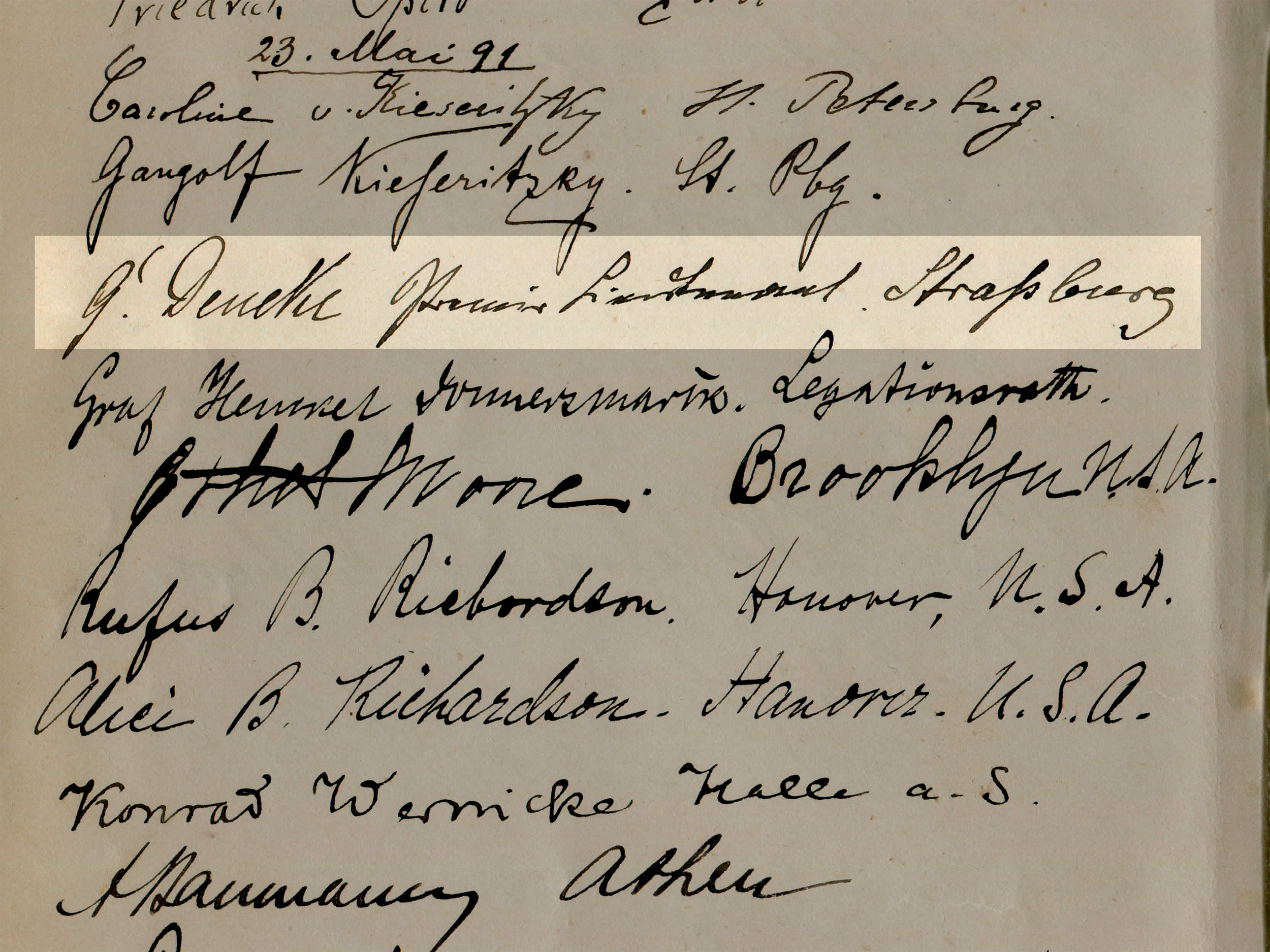
In the summer of 1891, Deneke (born on 15th of April 1856) worked alongside a Captain Winterberger on the survey of northern Attica and Salamis (Dörpfeld 1891, 446; Lohmann 2010, 270–272 fig. 1, tab. 2. 3, pl. 54, 2). After a brief recreational trip to Constantinople (today Istanbul), he returned to Athens in early October. Although he apparently did not feel well, he travelled to northern Attica to resume his work. He was forced to return to the city after only a few days, however, on account of a high fever. The diagnosis was typhus. Ziehen (Ziehen 1980, 150) gives a vivid account of his encounter with the critically ill man: “I was alone at the Institute on the night he returned and shocked when his batman asked me to see his sick captain. Even laymen could see that his condition was hopeless; it was written on the severely feverish patient’s face. He asked me to give him a glass of cognac […]. Medical assistance was brought in that same evening, and the poor man […] was transferred to Evangelismos, the German [sic] hospital, the very next day. He lay there in great suffering for a few days and, among others, found a touchingly devoted consoler and carer in the ambassador’s wife, Countess von Wesdehlen.” Deneke died on October 27, 1891, and was buried at the First Cemetery of Athens with military honours (Dörpfeld 1891, 446). The funeral cortege included Otto Lüders, the German consul in Piraeus and former director (1874–1875) of the DAI Athens, and Winterberger and Dörpfeld in captain’s uniforms (Ziehen 1980, 151). Dörpfeld gave the eulogy. His tribute to Deneke survives in written form in the notebook that lists the talks given at the Institute (fig. 9). According to Dörpfeld’s ‘Private’ list no. “60”, a photograph was also taken of Deneke’s coffin (fig. 6). It was presumably sent to his poor mother.
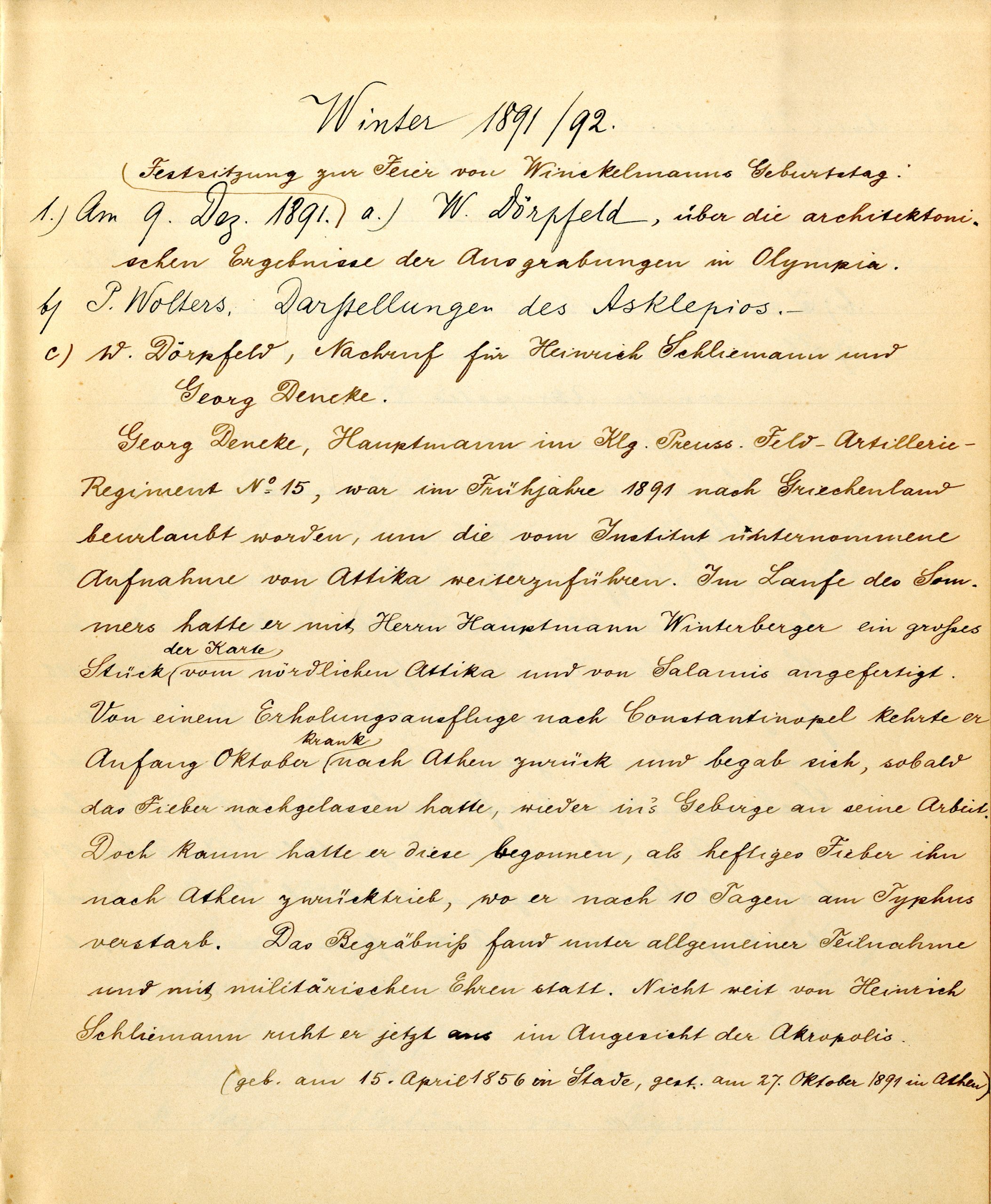
Deneke’s sudden death profoundly shook the people who worked at the Institute and is mentioned several times in the correspondence between Athens and the Executive Committee in Berlin that survives in the archive. In addition to coping with grief, mundane measures also had to be taken, such as disinfecting the room where Deneke had lived. It may have been because of the consternation over Deneke’s death that one of the few photographs of people in the photographic archive in Athens that preserves the names of the people photographed is one of Captain Deneke, taken during his fieldwork (fig. 10 a. b).
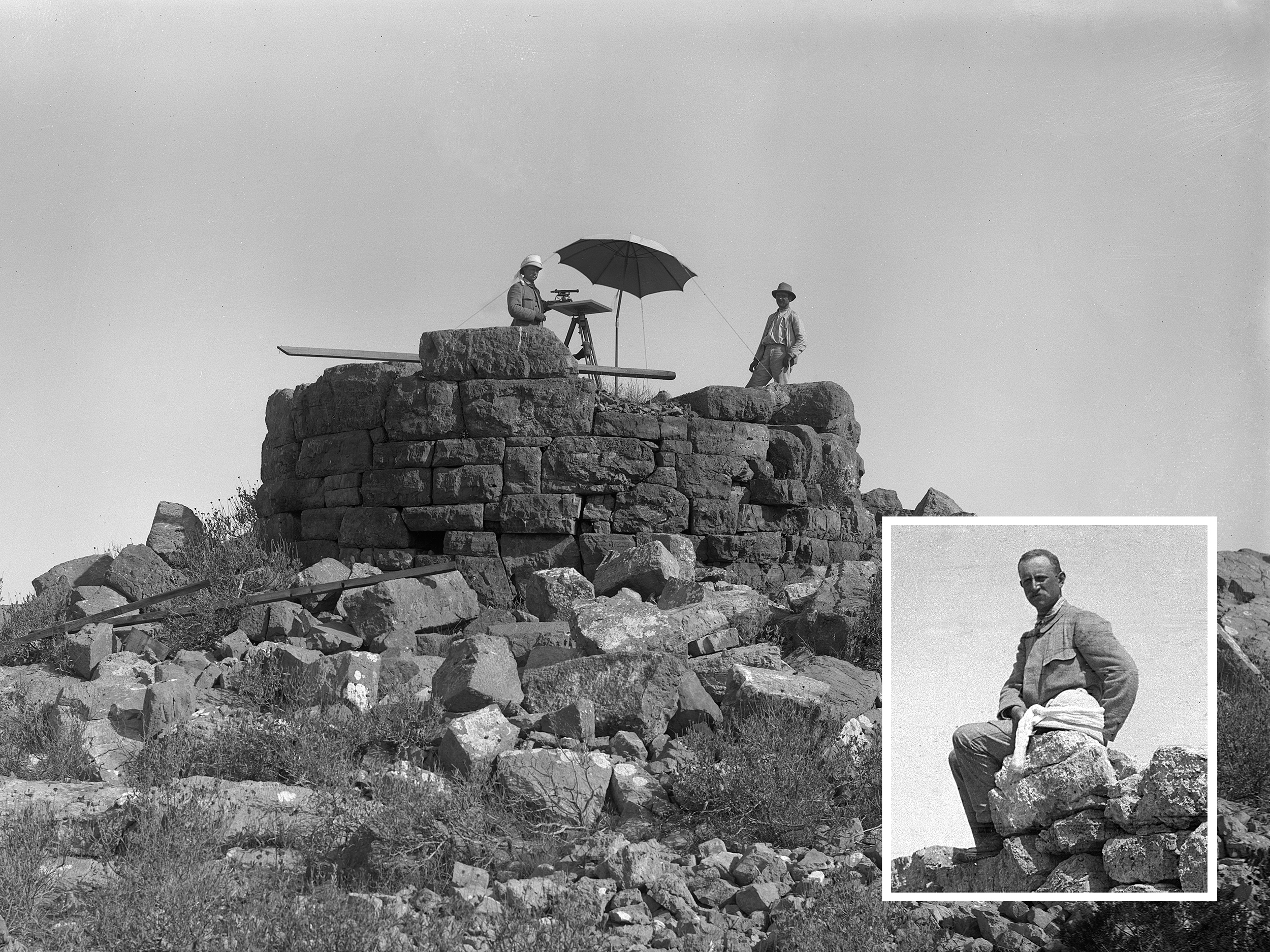
As a collaborator of ‘Karten von Attika’, Deneke was commemorated not only in the Athenische Mitteilungen (Dörpfeld 1891, 445 f.), but also in Archäologischer Anzeiger (anonymous 1891, 161), the scholarly reporting venue of the entire German Archaeological Institute. The latter obituary in particular contains detailed information about the officer’s military career.
With that, the circle that the photograph ‘Mykene 63’ draws around people active at the DAI Athens in 1890–1892 comes to a close.
This entry is dedicated to Joachim Heiden, the director of the photographic archive of the DAI Athens from 2007 to 2020, who always doubted that the person standing next to the right lion was really the elderly Schliemann, let alone that Schliemann – at the age of 63 – would have climbed up there – doubts that only grew every time the archive received a new request to publish ‘Mykene 63’.
Works cited and further reading:
Anonymous 1891
Anonymous, Nachruf auf Georg Deneke, in: AA 1891, 161
Barth 1936
W. Barth, Geschichte der Deutschen Gesellschaft Philadelphia in Athen (Athens 1936)
Bringmann 2001
C. Bringmann, Handbuch der Diplomatie, 1815–1963: Auswärtige Missionschefs in Deutschland und Deutsche Missionschefs im Ausland von Metternich bis Adenauer (Berlin 2001)
Curtius 1913
F. Curtius, Ernst Curtius. Ein Lebensbild in Briefen (Berlin 1913)
Curtius – Kaupert 1895–1903
Curtius – J. Kaupert, Die Karten von Attika (Berlin 1895–1903)
https://doi.org/10.11588/diglit.776#0003
Döhl 1981
H. Döhl, Heinrich Schliemann: Mythos und Ärgernis (München 1981)
Dörpfeld 1891
W. Dörpfeld, Nachruf auf Georg Deneke, in: AM 16, 1891, 445 f.
Lohmann 2010
H. Lohmann, Die „preussischen“ Karten von Attika, in: H. Lohmann – T. Mattern (eds.), Attika – Archäologie einer „zentralen“ Kulturlandschaft. Akten der internationalen Tagung vom 18.–20. Mai 2007 in Marburg. Philippika –Marburger altertumskundliche Abhandlungen 37 (Wiesbaden 2010) 263–279
Rottloff 2009
A. Rottloff, Die berühmten Archäologen (Mainz 2009)
Wikipedia s.v. „Heinrich Schliemann“ (Access: 17.6.2022)
Ziehen 1980
H. Ziehen (ed.), Julius Ziehen: Erinnerungen 1864–1925 (Frankfurt 1980).
